22 Free Friendship Skills Activities for PK–12 Students
Get free social skills materials every week
No-prep lessons on self-regulation, emotional recognition, conversation skills, and more.
Sign up hereFriendship skills help students build meaningful peer relationships, navigate social situations, and feel a sense of belonging at school. Some students develop these skills naturally, while others need explicit instruction and repeated practice to build confidence and connection.
This guide brings together practical strategies, clear explanations, and free activities to help you teach friendship skills across all grade levels. Whether you are working with preschoolers who are just learning how to share or high school students managing complex peer dynamics, you will find ready-to-use lessons, printables, and games that make teaching friendship skills easier and more effective.
Get Free Activities for Friendship Skills
Printable lessons, games, posters, and interactive activities that teach essential friendship skills with zero prep required
What Are Friendship Skills?
Friendship skills are the social and communication abilities students use to build and maintain positive peer relationships. These skills include both verbal and nonverbal behaviors that help students connect with others, navigate differences, and sustain friendships over time.
Examples of core friendship skills include:
- Starting and maintaining conversations
- Inviting others to join play or activities
- Taking turns and sharing
- Showing interest in others’ ideas and feelings
- Handling conflicts in respectful ways
- Recognizing and repairing hurt feelings
- Offering and receiving compliments
- Demonstrating fairness and good sportsmanship
While some students pick up these skills naturally, many benefit from explicit modeling, guided practice, and repeated reinforcement in structured settings.
Why Friendship Skills Are Important
Strong friendship skills support students’ social, emotional, and academic development. When students know how to build and maintain friendships, they are more likely to feel included, participate actively in class, and develop a sense of belonging at school.
Teaching friendship skills helps students:
- Form healthy peer connections
- Practice empathy and perspective-taking
- Build confidence in social settings
- Reduce conflict and social isolation
- Strengthen communication and problem-solving skills
These skills do not just shape students’ current peer relationships. They lay the foundation for long-term interpersonal success inside and outside the classroom.
How to Teach Friendship Skills
Friendship skills are best taught through a combination of explicit instruction, guided practice, and authentic application. Educators can embed friendship skill-building into daily routines, small-group lessons, or targeted interventions for students who need more support.
Effective approaches include:
- Modeling and think-alouds: Show students what the skill looks and sounds like.
- Role-play and practice: Let students rehearse skills in structured, low-stakes situations.
- Visual supports and reminders: Use posters, goal charts, and worksheets to make abstract skills concrete.
- Interactive games and activities: Give students engaging opportunities to use friendship skills in real time.
- Reinforcement throughout the day: Prompt and praise the use of skills during natural interactions, not just during lessons.
These strategies create a consistent, supportive environment where students can learn, apply, and refine the skills that help them form meaningful friendships.
Free Friendship Skills Activities
Building and maintaining friendships is a critical part of every student’s school experience. The activities below give educators ready-to-use lessons, printables, interactive games, and visual supports that teach skills like making friends, handling conflict, inviting others to play, and showing good sportsmanship.
These free, no-prep resources are organized by grade level so you can find exactly what fits your students’ needs, from preschoolers just learning how to join a game to high schoolers navigating complex peer dynamics. Use them during classroom lessons, small-group sessions, or informal social times to help students strengthen real-world friendship skills in meaningful ways.
Get Free Activities for Friendship Skills
Printable lessons, games, posters, and interactive activities that teach essential friendship skills with zero prep required
Friendship Skills Activities for Pre-K and Kindergarten
Conflict Resolution
Preschool Free Lesson Plan: Teaching Preschoolers to Resolve Conflict
This free lesson plan teaches preschoolers how to resolve conflict by introducing simple steps like “Stop,” “Tell what you want,” and “Think of solutions.” It helps young children name feelings, use words instead of hitting or pushing, and find ways to make things better.
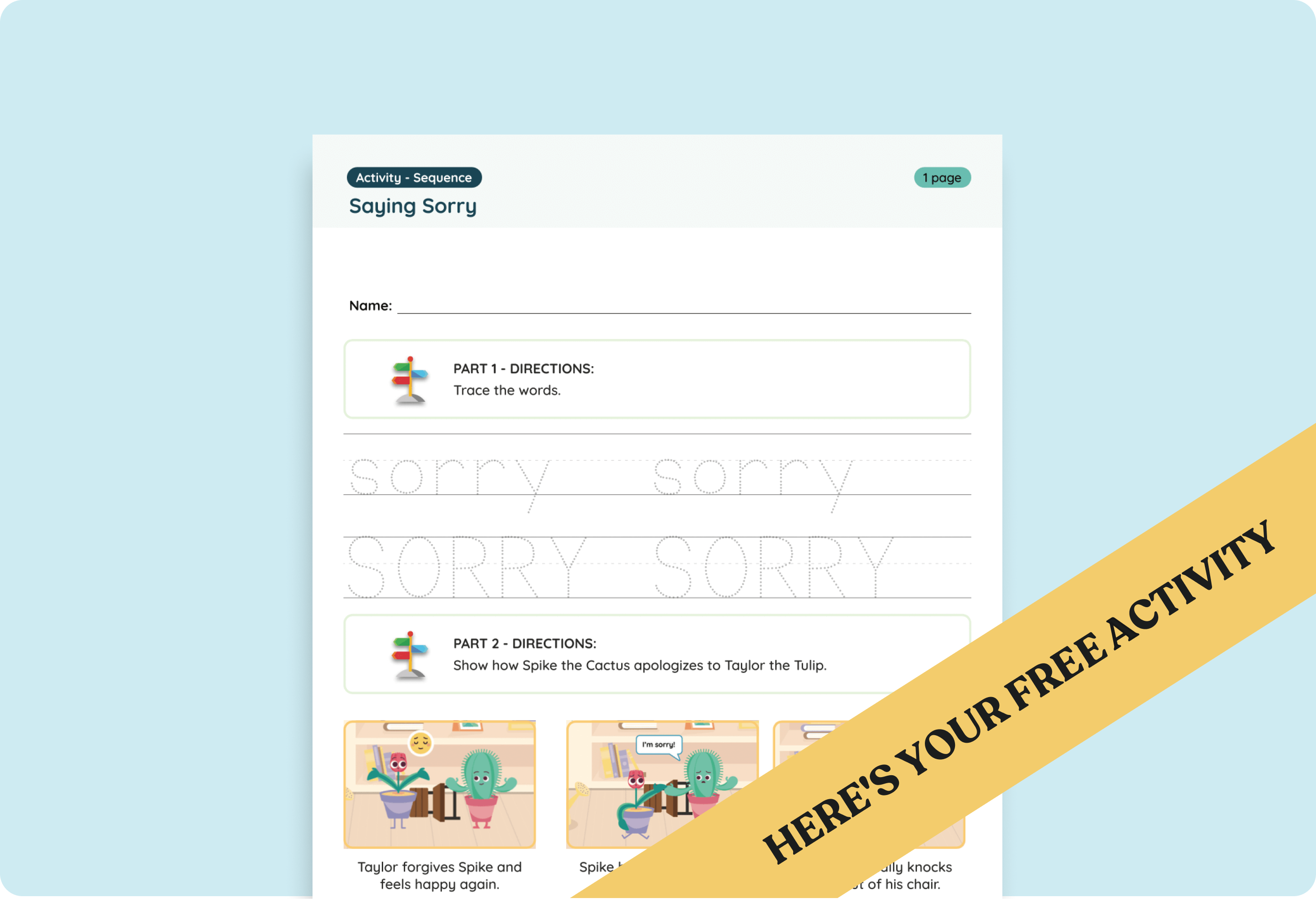
How to use it: Use it in circle time, small-group lessons, or during free-play transitions. Begin by discussing common conflicts (e.g. two kids wanting the same toy), then role-play the three resolution steps. Afterward, pair students and let them try resolving mini conflicts with your support, and debrief by asking: “Which solution did you try? Did it work? What would you do differently next time?”
Making Mistakes
Pre-K & Kindergarten Free Lesson Plan & Worksheet: Making Mistakes
This free lesson helps preschoolers learn how to make mistakes well by introducing simple strategies like staying calm, telling the truth, and taking responsibility. It includes a matching-activity worksheet and discussion prompts.
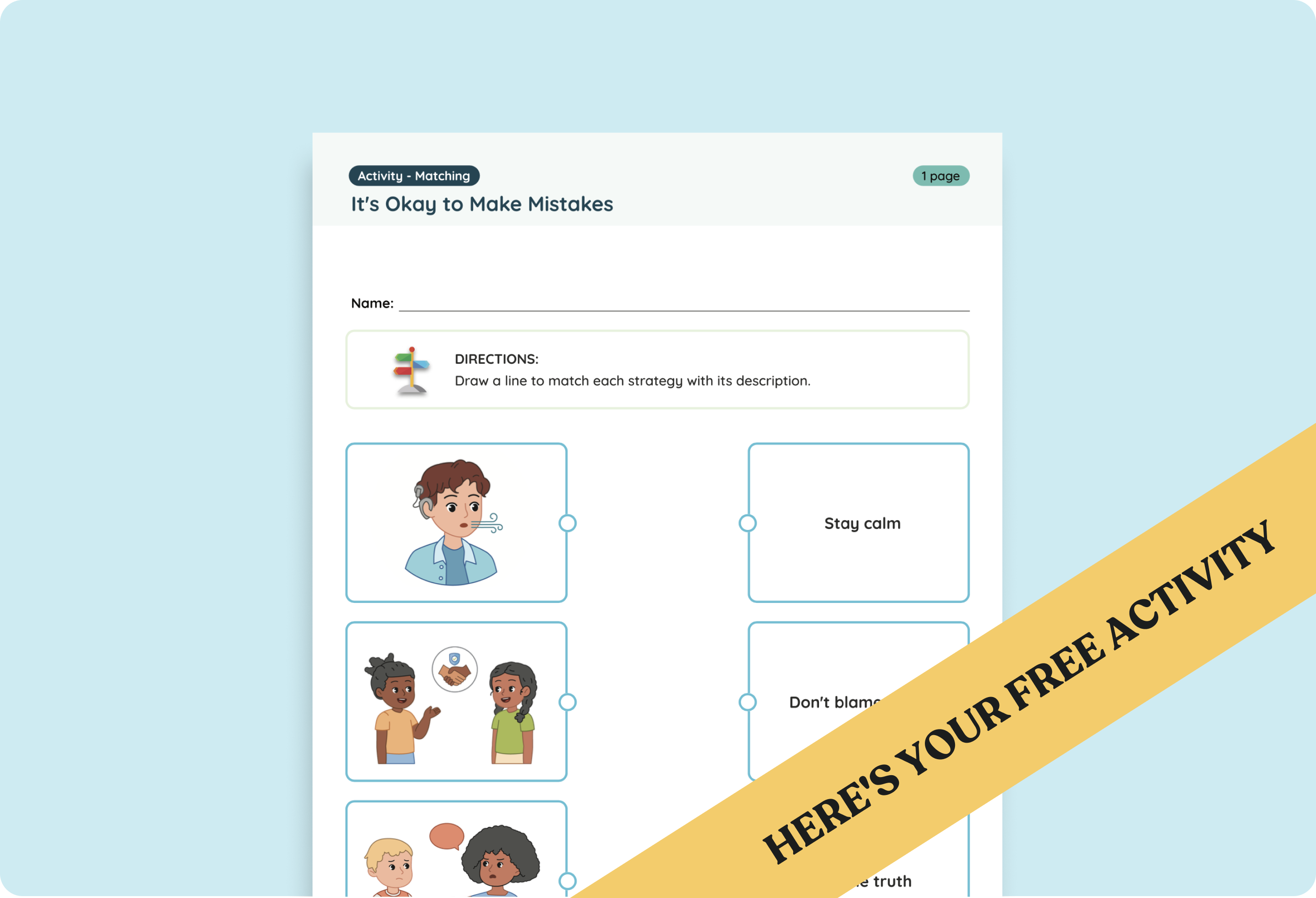
How to use it: Use it during circle time, morning meetings, or small-group lessons. Begin with a discussion of times when we all make mistakes, model staying calm when you make a mistake, then distribute the worksheet where children match actions to “staying calm,” “telling the truth,” or “taking responsibility.” After pairing or group work, reconvene to share reflections and debrief: “What helps when I make a mistake?”
Sharing with Friends
Pre-K & Kindergarten Free Printable & Lesson Plan: Sharing Material
This free resource helps preschoolers practice how to share with others through simple, age-appropriate activities like “share and tell,” turn-taking prompts, and sharing stories.
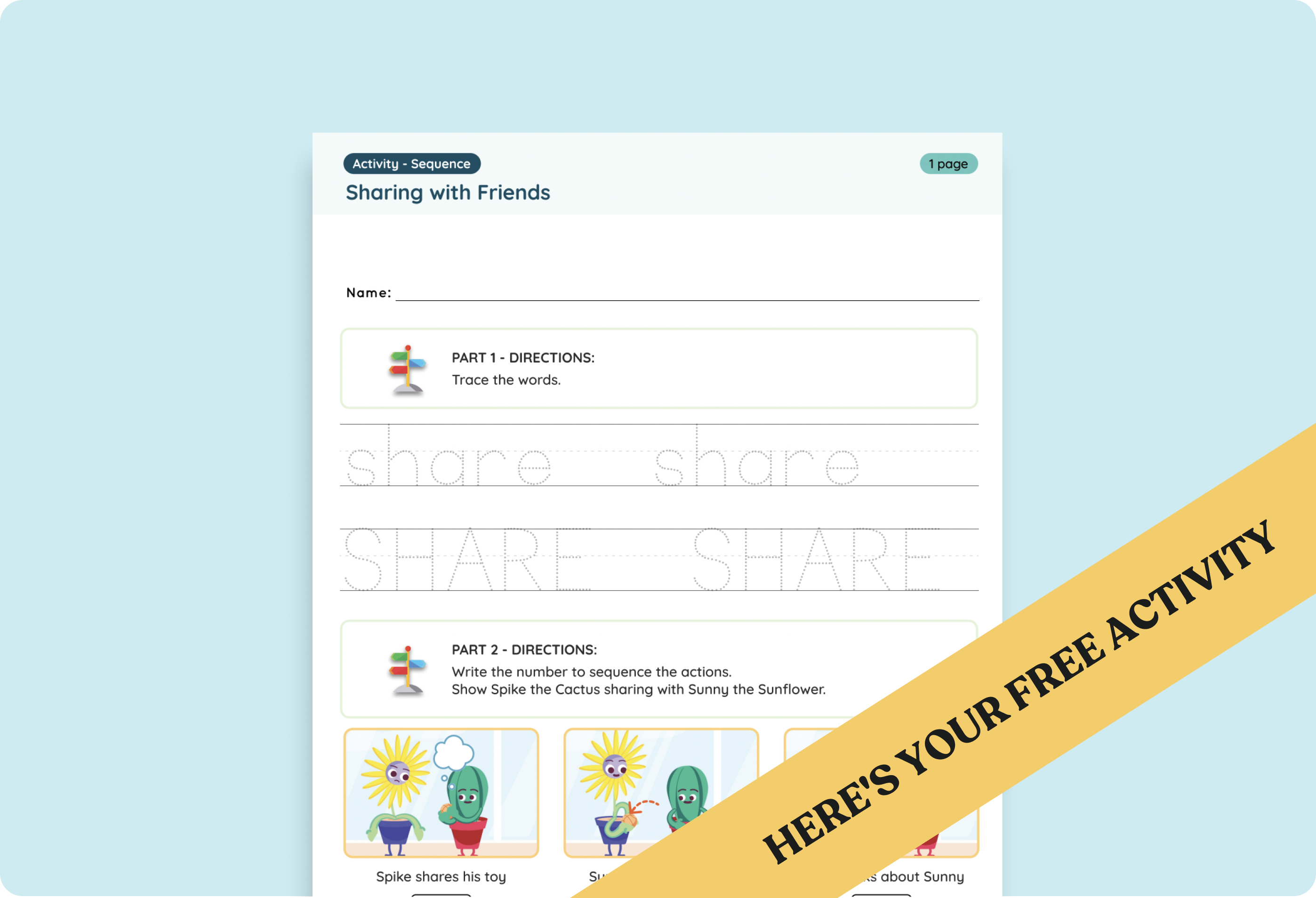
How to use it: Use it during circle time, small-group play, or transitions. Start by modeling what sharing looks like (e.g. “I’ll give it to you next”) and talk through why sharing matters. Then distribute the “Sharing Material” worksheets or prompts, let children try sharing in partner or small-group play, and debrief by asking: “How did it feel to share? What was hard?”
Joining a Group
Pre-K & Kindergarten Free Lesson Plan & Worksheet Activity: Joining a Group
This free lesson plan helps preschoolers learn how to join a group during play by introducing steps like observing, waiting, and asking. It guides children to make entry attempts into peer groups in respectful ways and supports them through scaffolding and practice.
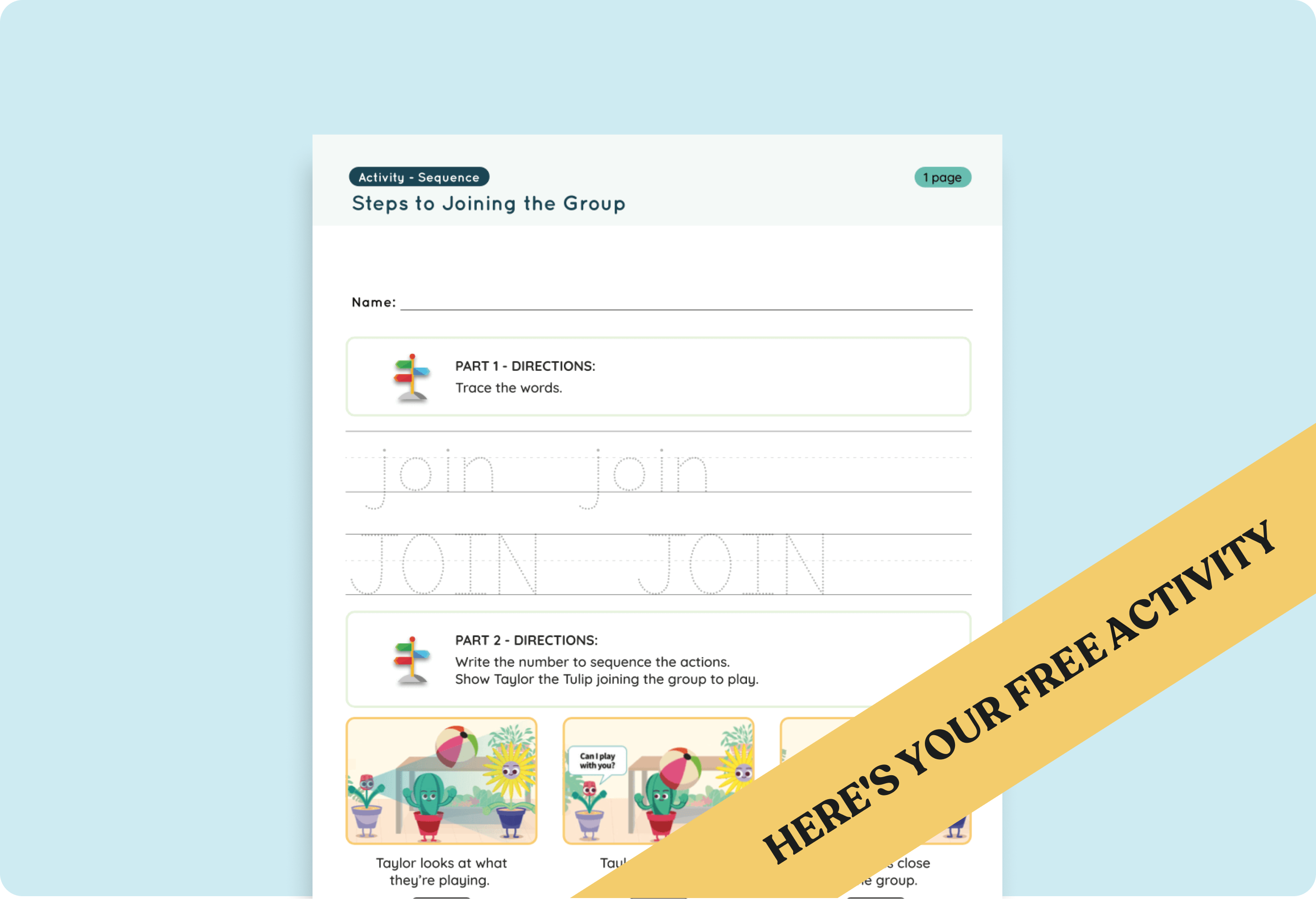
How to use it: Use it in circle time, small-group play, or classroom transitions. Start by modeling or role-playing what to do when you want to join others. Then distribute the “Steps to Joining the Group” worksheet, walk through it together, and have kids practice with peers. During free play, prompt students to try the steps and check in afterward: “How did it go? What helped?”
Asking a Friend to Play
Pre-K & Kindergarten Free Activity & Lesson Plan: Practicing Asking a Friend to Play
This free activity helps preschoolers learn how to ask a friend to play by offering illustrated scenarios, discussion prompts, and guided invitation practice.
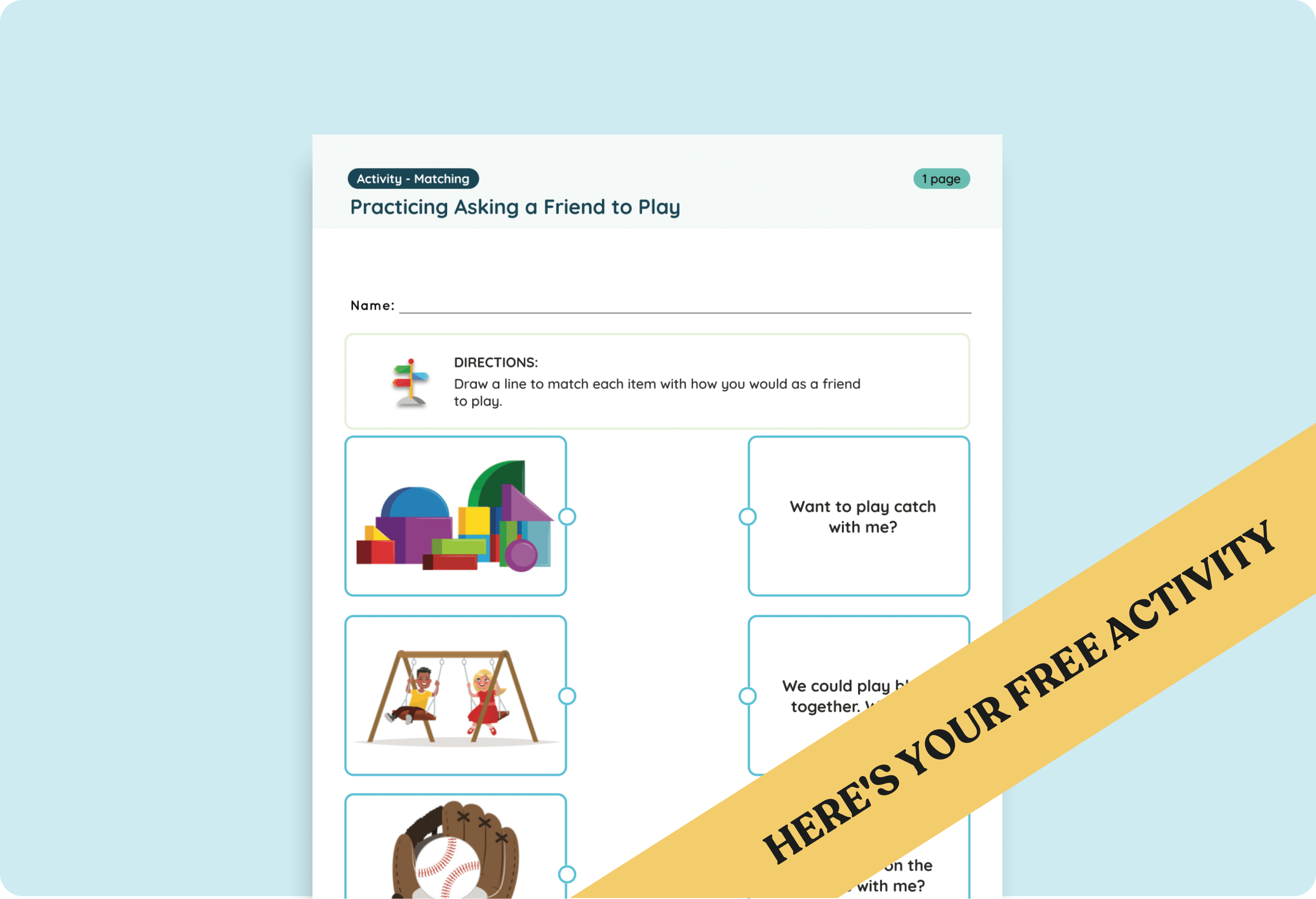
How to use it: Use it in circle time, small groups, or during structured play prep. Introduce the idea by modeling friendly invitation phrases (like “Would you like to play with me?”), then hand out the activity sheets. Let students take turns role-playing both inviting and accepting invitations. Afterward, lead a discussion: “What made it easy or hard to ask someone to play? What could you try next time?”
Being Fair with Others
Pre-K & Kindergarten Free Interactive Activity & Lesson Plan: Being Fair with Others
This free resource helps preschoolers learn how to play fairly with others through a matching exercise that connects images with fairness strategies (like taking turns, playing by the rules, and thinking about others).
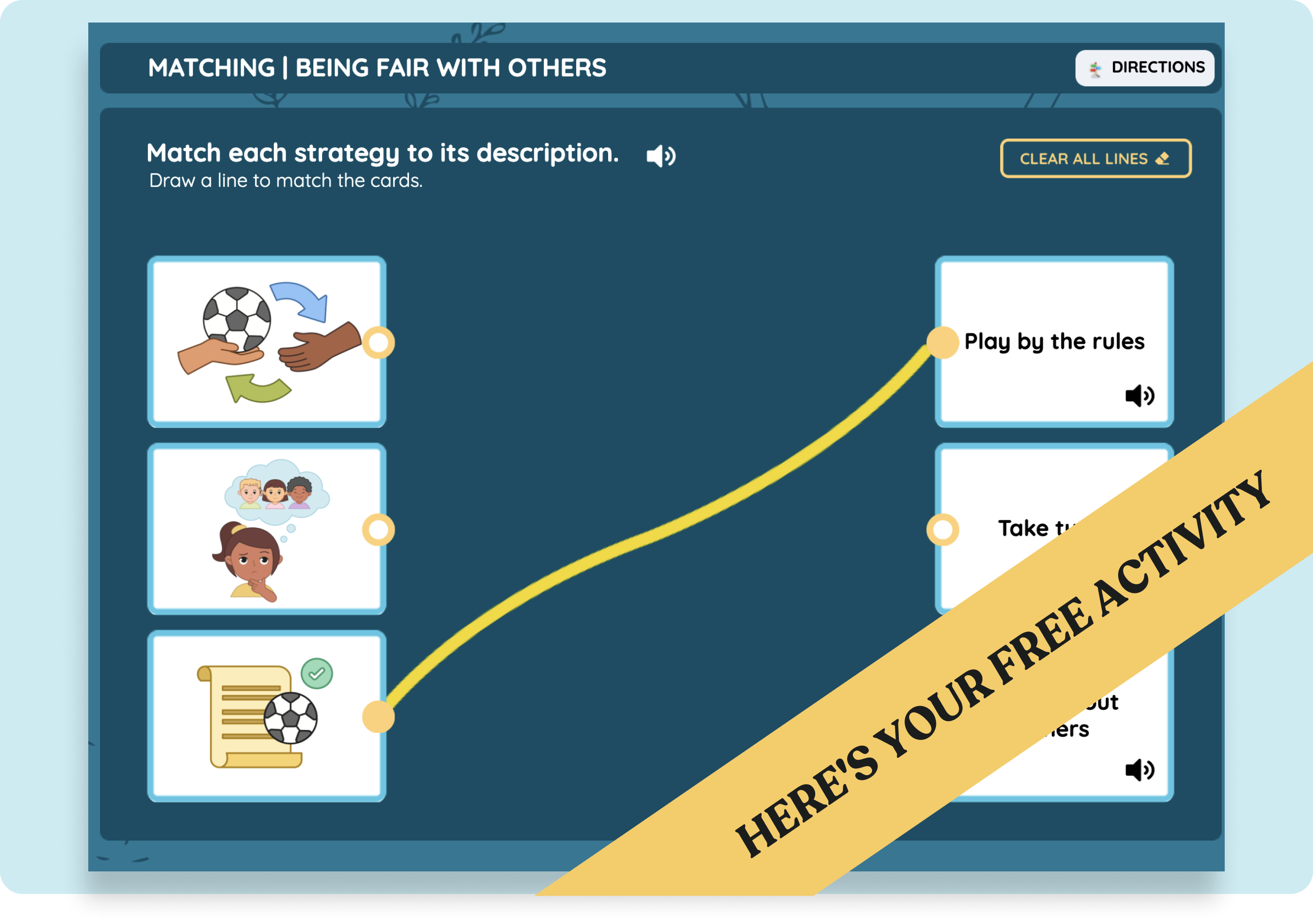
How to use it: Use it during circle time, small groups, or structured play prep. Begin by talking about what fairness means and show examples (e.g. sharing toys, letting others have a turn). Then distribute or project the matching activity, and let students pair pictures with descriptions. Afterward, review student matches and discuss: “Why is this fair? What would you do differently?” Encourage students to try using these fairness strategies during play time and reflect afterward on how it went.
Friendship Skills Activities for Elementary School
Friendship Board Game
Elementary Free Activity & Lesson Plan: Friendship Board Game
This free board game helps elementary students learn about friendship by exploring core skills through play. It gives children practice with turn-taking, showing interest, solving conflicts, acting like a friend, and communicating effectively, all in a game format that feels fun and interactive. The resource includes a full game board and facilitation guide.
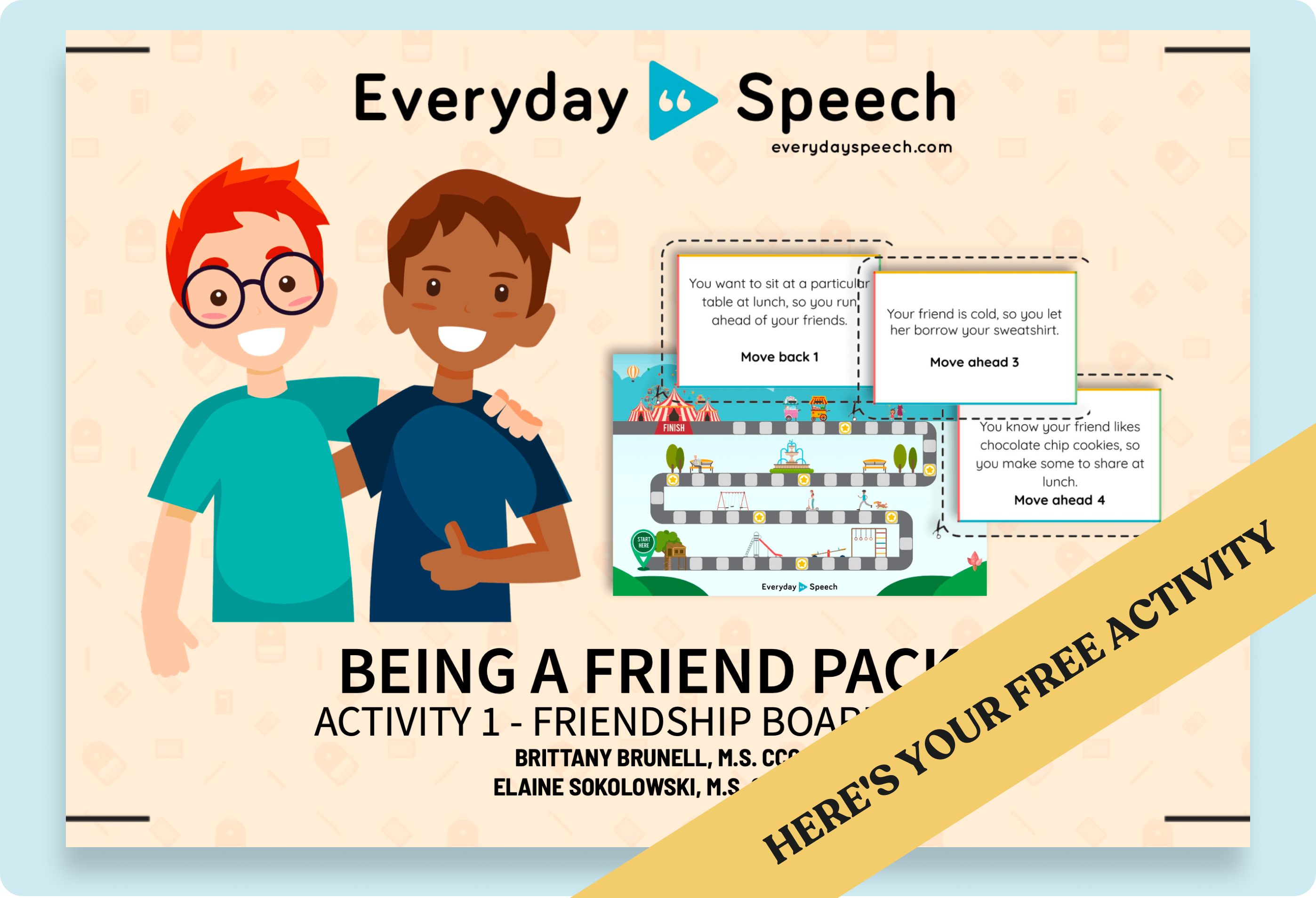
How to use it: Use it in classroom centers, small groups, or during social time. Set students into small groups, give each group a game board (printed or digital), and have them take turns progressing through the board. Prompt reflection at key moments: “Why did you choose that response?” or “How would you feel if someone did that to you?” After the game, bring students together to share takeaways and discuss which strategies felt helpful or tough.
Solving Problems on the Playground
Elementary Free Worksheet & Lesson Plan: Solving Problems on the Playground
This free lesson plan helps elementary students practice how to solve problems on the playground by teaching them a structured approach: identify the problem, decide if help is needed, brainstorm solutions, choose one, and check if it worked.
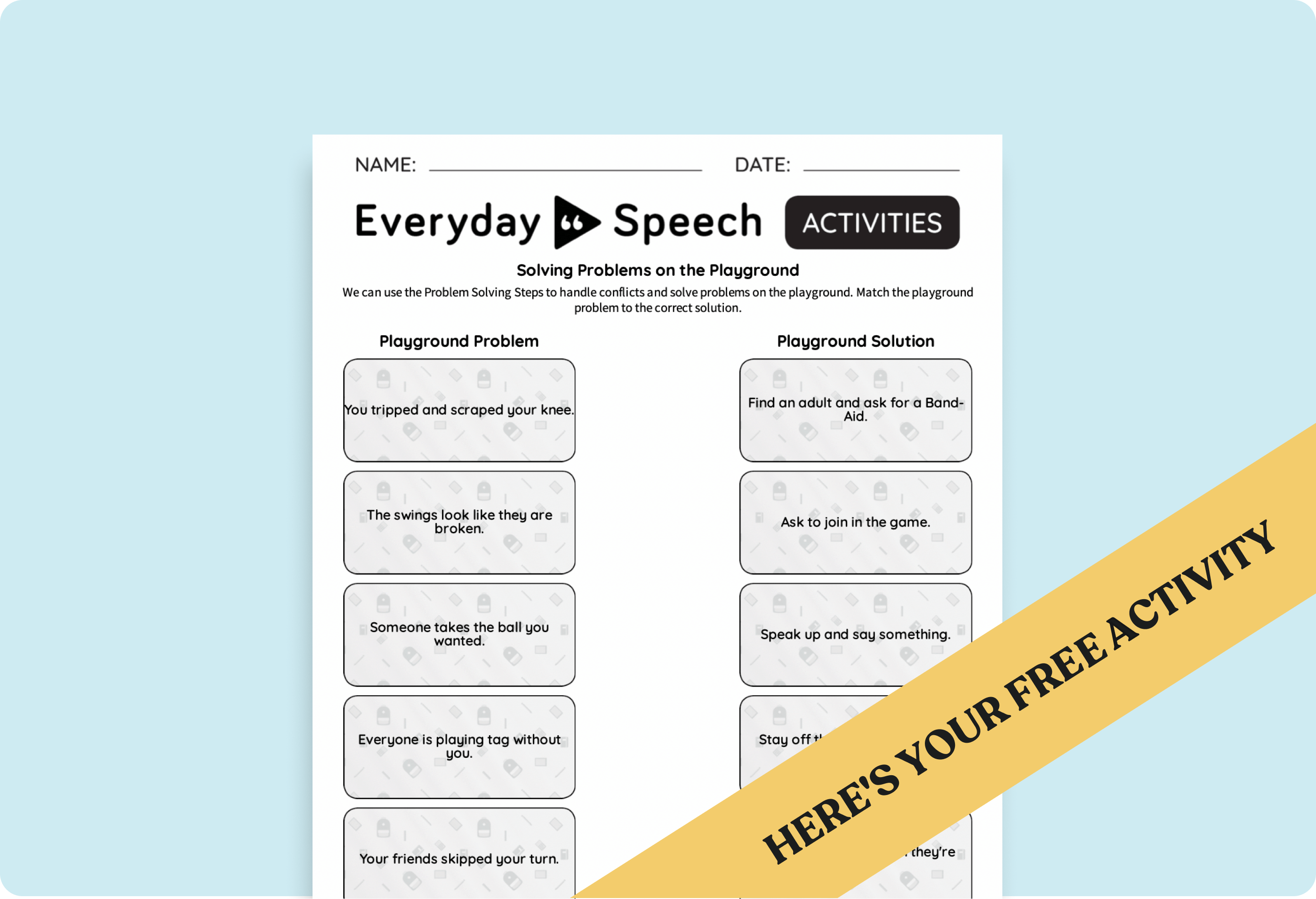
How to use it: Use it in classroom lessons, during recess debriefs, or in small groups focused on peer skills. Start with a class discussion about what being a “good sport” means and why problem-solving is important. Introduce the problem-solving steps (on chart or board), then hand out the “Solving Problems on the Playground” worksheet. Have students complete the matching scenarios, then discuss their thinking, compare solutions, and invite them to share how they might use these steps during future playground interactions.
Inviting Others to Play
Elementary Free Interactive Activity & Lesson Plan: Inviting Others to Play
This free interactive resource helps elementary students practice how to invite others to play by differentiating inviting vs. non-inviting behaviors through a digital sorting exercise, then reflecting on inclusion and empathy.
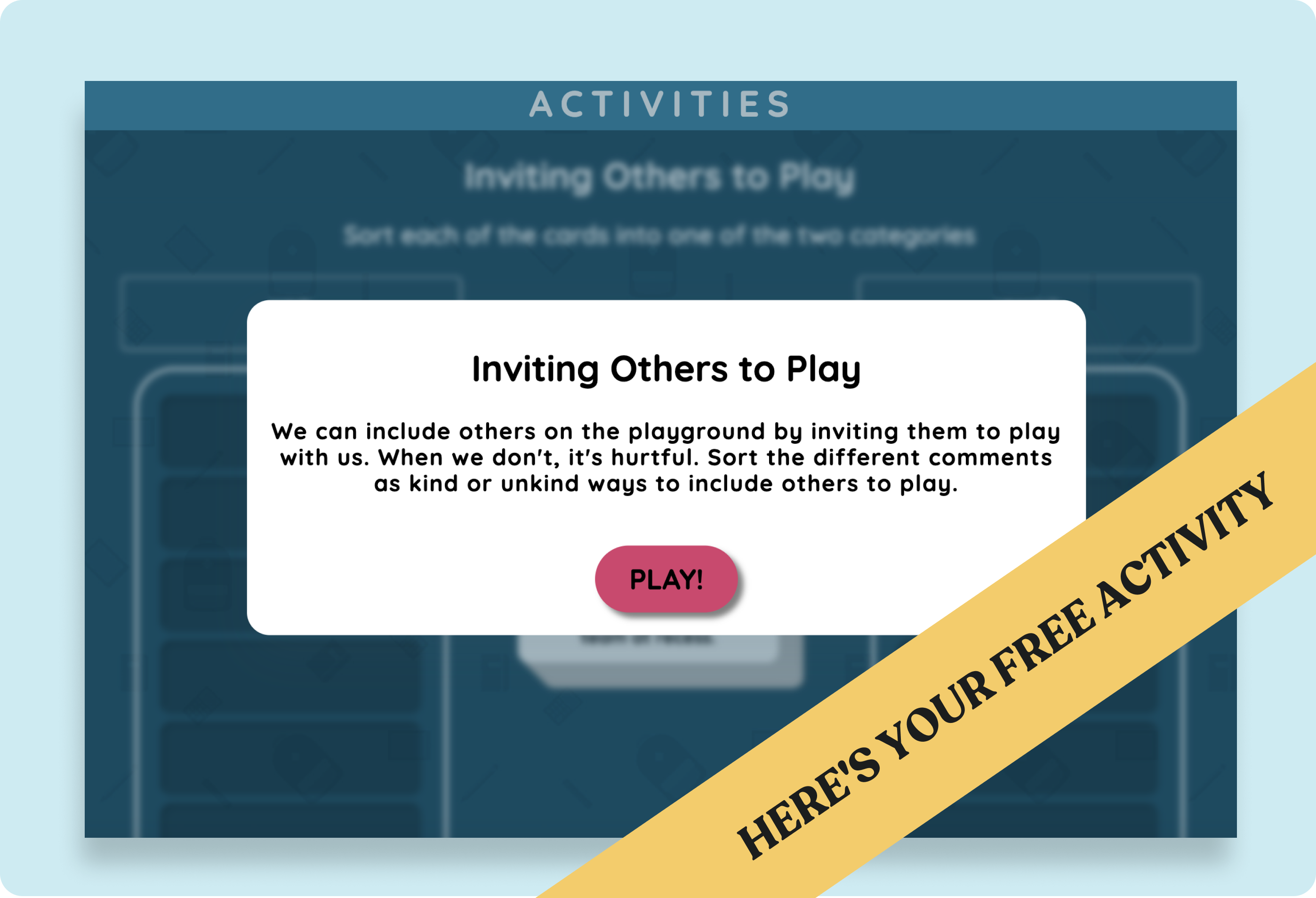
How to use it: Use it in classroom centers, small groups, or during free play introductions. Project or distribute the interactive sorting activity and have students sort card prompts as inviting or not. Pause to discuss choices, ask students what they would do differently, and then lead a reflection: “How can I make sure no one feels left out?”
Play Skills for Kids
Elementary Free Printable & Lesson Plan: Play SkillsThis free activity helps elementary students practice how to initiate and navigate play skills by breaking down steps like approaching a group, getting attention, making an invitation, and accepting declines gracefully.
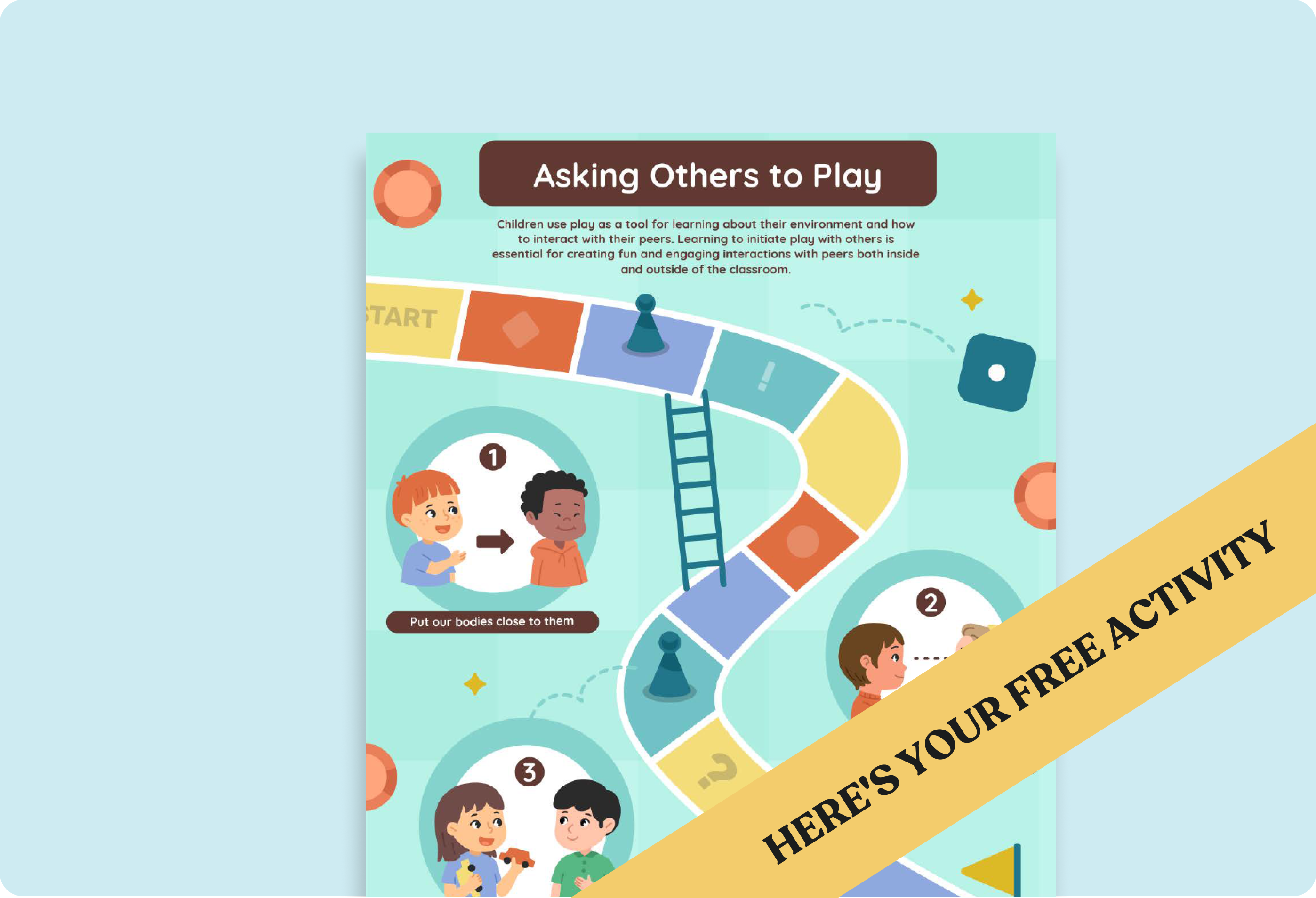
How to use it: Use it in classroom centers, recess prep sessions, or small-group settings focused on peer interaction. Start by discussing times when it’s hard to join others, introduce the three-step approach (get close, gain attention, ask), and use the goal poster as a visual scaffold. Then distribute the play skills worksheets, role-play scenarios, and have students reflect on how they might use these steps in real play situations.
Good Sportsmanship Poster
Elementary Free Poster & Lesson Plan: Good Sportsmanship Poster
This free visual poster and companion lesson help elementary students internalize what good sportsmanship looks like through key behaviors like fairness, encouragement, handling wins/losses, and positive language. The poster becomes a reference in the classroom to anchor discussions and reflections.
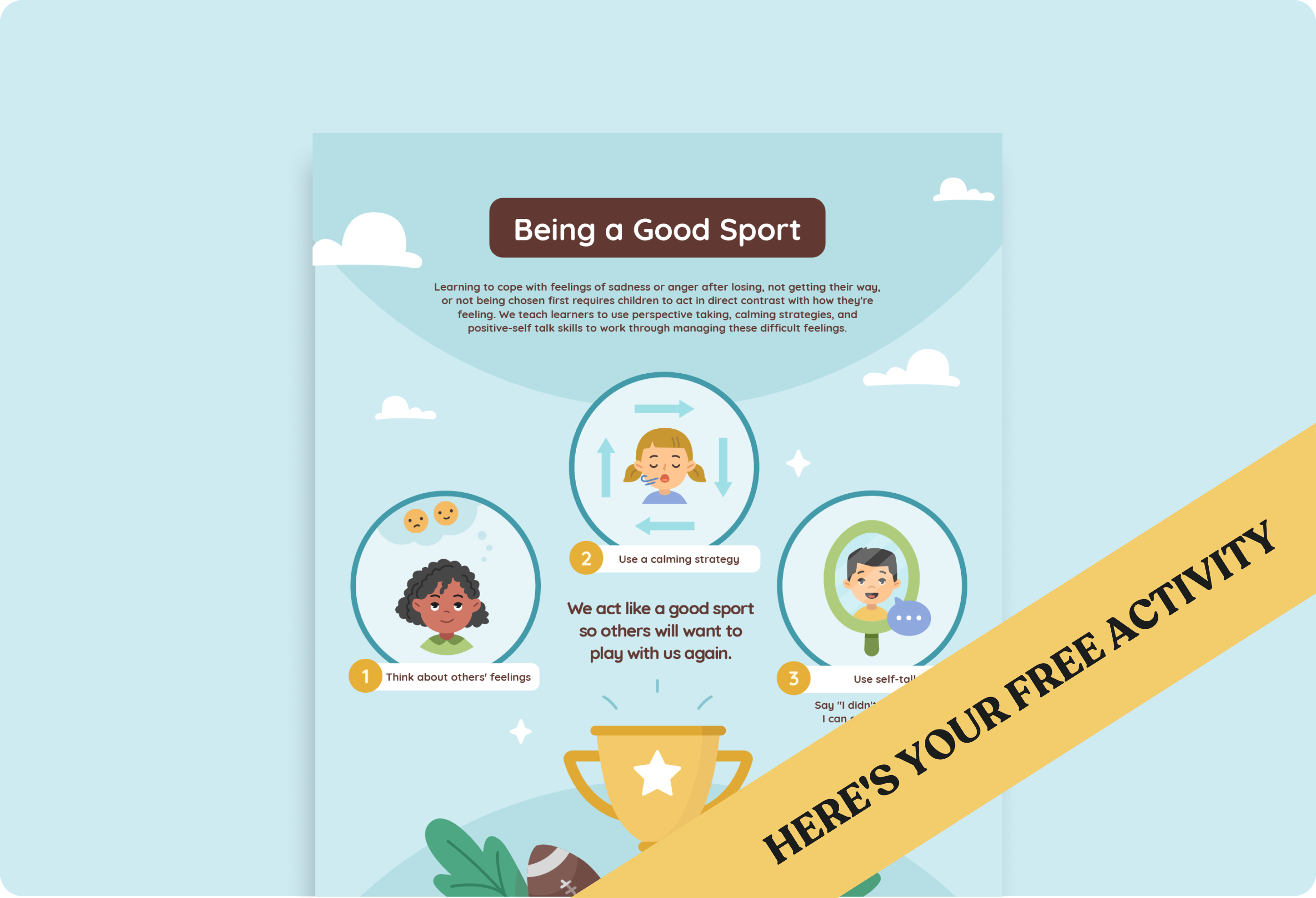
How to use it: Use it in classroom settings, shared spaces like the gym or play area, or during group lessons about peer interactions. Begin by asking students what it means to play fair, then introduce the “Good Sportsmanship” poster and walk through each behavior with real examples. Encourage students to name times they’ve seen or practiced that behavior. Revisit the poster regularly—before games, free-play time, or competitions—and prompt students to notice when classmates model good sportsmanship.
Including Everyone on the Playground
Elementary Free Video Lesson & Lesson Plan: Including Everyone on the Playground
This free video lesson helps elementary students practice how to include peers on the playground by modeling inclusive behaviors, engaging in sorting activities for inviting vs excluding statements, and building class-generated rules to promote belonging.
How to use it: Use it during classroom lessons, recess prep times, or group sessions focused on peer relationships. Start with a discussion about what inclusion means, show the “Including Everyone on the Playground” video, then distribute the sorting worksheet. After students complete the activity, lead a conversation about their choices and brainstorm class rules for inclusion. Revisit those rules before free-play times to reinforce inclusive habits.
Being a Friend
Elementary Free Printable & Lesson Plan: Being a Friend Packet
This free packet helps elementary students practice how to be a good friend through activities on conversation, empathy, problem-solving, turn-taking, and making friends. It gives students structured opportunities to build and reinforce positive friendship skills in real-life situations.
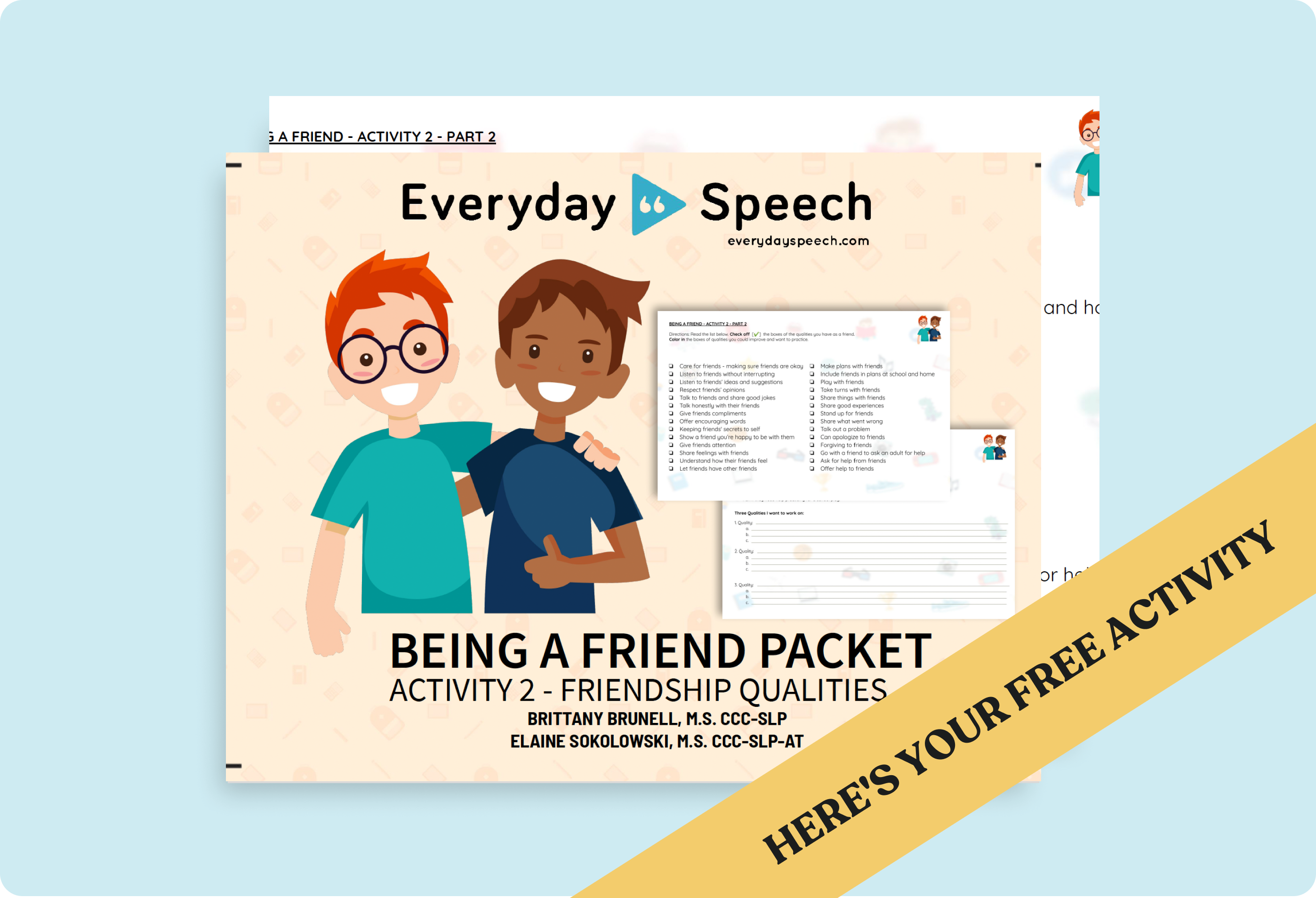
How to use it: Use it during classroom centers, partner work, or small-group sessions focused on peer skills. Start with the “What Makes a Good Friend?” worksheet to prompt discussion, then move through the various scenario pages, “Friendship Words,” and “Solving Problems with Friends” activities. Invite students to role-play responses, reflect on choices, and set a “My Friendship Goal” for the coming week.
Friendship Skills Activities for Middle & High School
When Friends Don’t Act Like Friends
Middle School Free Activity & Lesson Plan: When Friends Don’t Act Like Friends
This free lesson helps middle schoolers explore when friends don’t act like friends by working through realistic vignettes, reflecting on feelings, and brainstorming healthy responses. It supports them in recognizing hurtful behaviors and deciding how to respond thoughtfully.
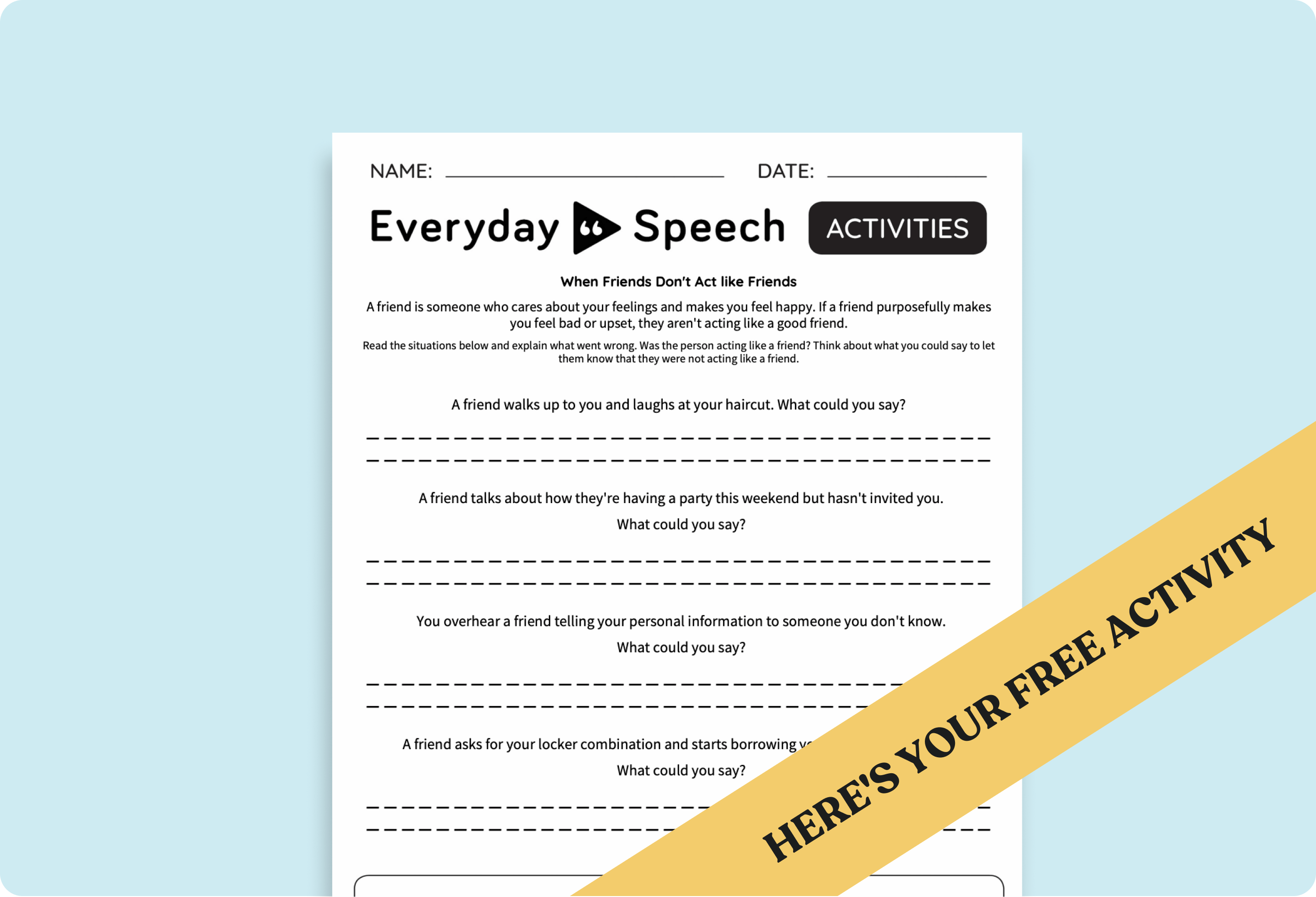
How to use it: Use this in advisory, classroom lessons, or small-group settings focused on peer relationships. Begin by asking students to name qualities of good friends and normalize that sometimes friends make mistakes or disappoint each other. Then distribute the “When Friends Don’t Act like Friends” worksheet, have students reflect individually on a few vignettes, share in pairs or small groups, and compile response strategies together. Wrap up by having each student set a short goal or intention for handling conflict in friendships.
Handling Conflict with Friends
Middle School Free Lesson Plan: Handling Conflict with Friends
This free lesson plan teaches middle schoolers how to handle conflict with friends through a slow, step-by-step process that helps remove emotional reactivity and make decisions with everyone’s feelings in mind.
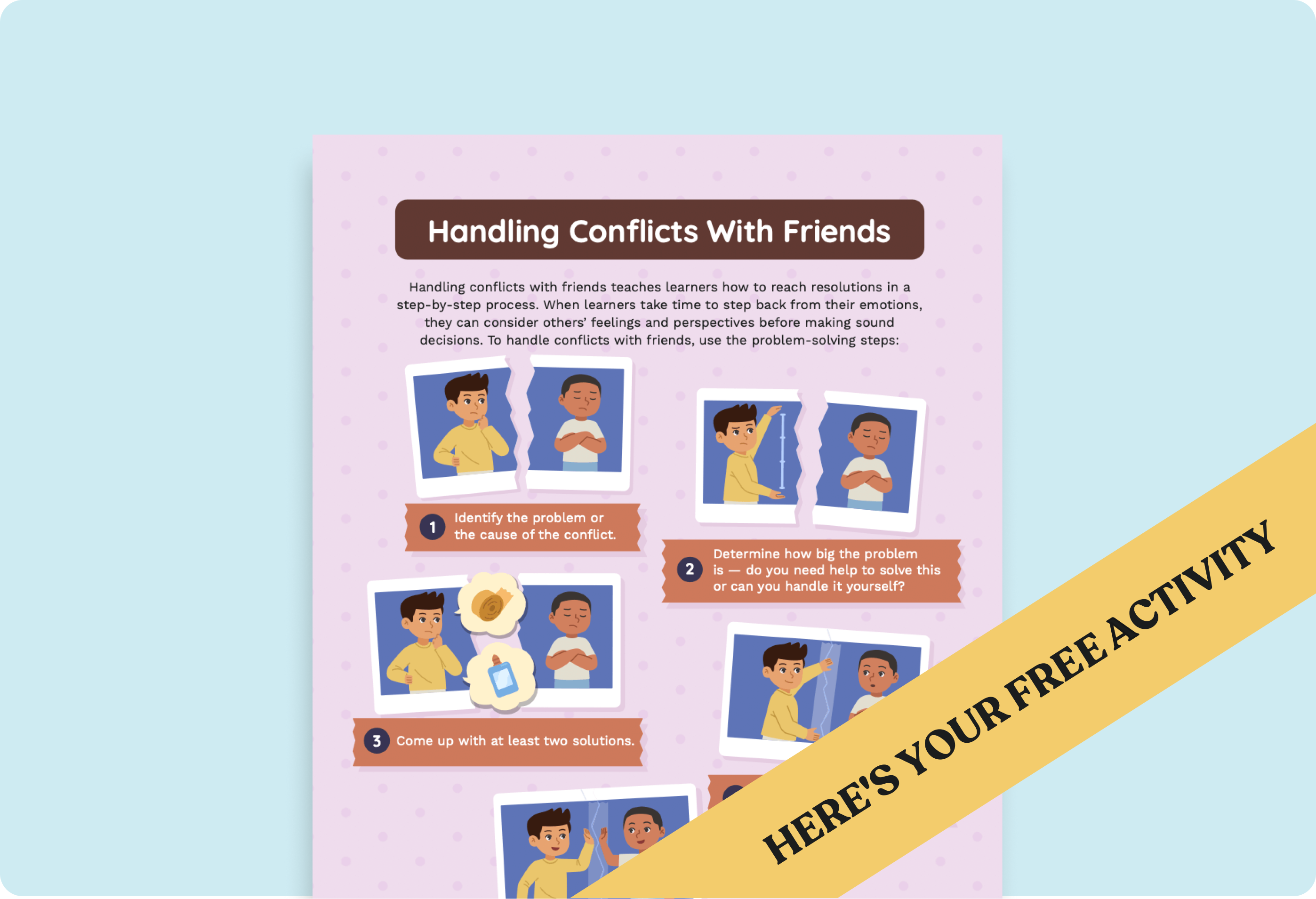
How to use it: Use it in advisory, small-group sessions, or classroom lessons focused on peer interactions. Start with a discussion about what conflict means and how different people can see the same situation differently. Then introduce the “Handling Conflicts with Friends” goal poster, hang it in the room for visual scaffolding, and have students role-play various peer conflict scenarios. Debrief afterward to reinforce the steps and reflect on strategies they used.
Acting Like a Friend
Middle School Free Poster & Lesson Plan: Acting Like a Friend
This free visual poster and companion lesson help middle schoolers understand how to act like a friend by making abstract qualities concrete. The resource highlights behaviors like listening, including others, showing respect, and apologizing, along with discussion prompts and activity suggestions. The poster anchors the lesson and serves as a constant reminder in the classroom.
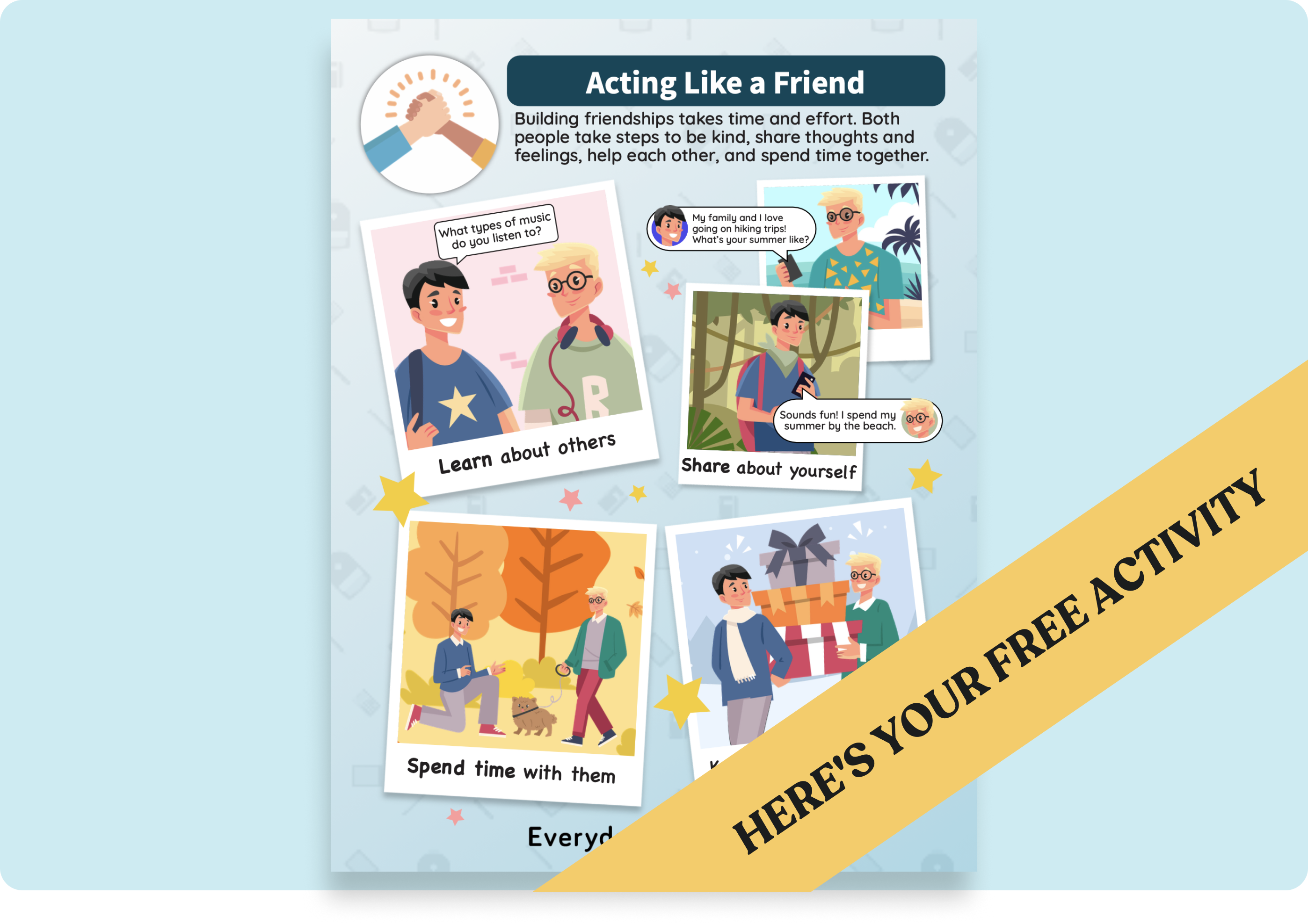
How to use it: Use it in advisory, small groups, or classroom settings focused on peer relationships. Begin by asking students what behaviors make someone a good friend, then introduce the “Acting Like a Friend” poster as a shared reference. Walk through each poster point with real-life examples, and follow with role-plays or scenario discussions where students practice selected behaviors. Finally, have students pick one behavior as a goal for the coming week and revisit the poster in check-ins.
Handling Change with Friends
Middle School Free Activity & Lesson Plan: Handling Change with Friends
This free worksheet and guided lesson help middle schoolers learn how to handle change within friendships by reflecting on evolving dynamics, exploring emotions, and building strategies for thoughtful responses.
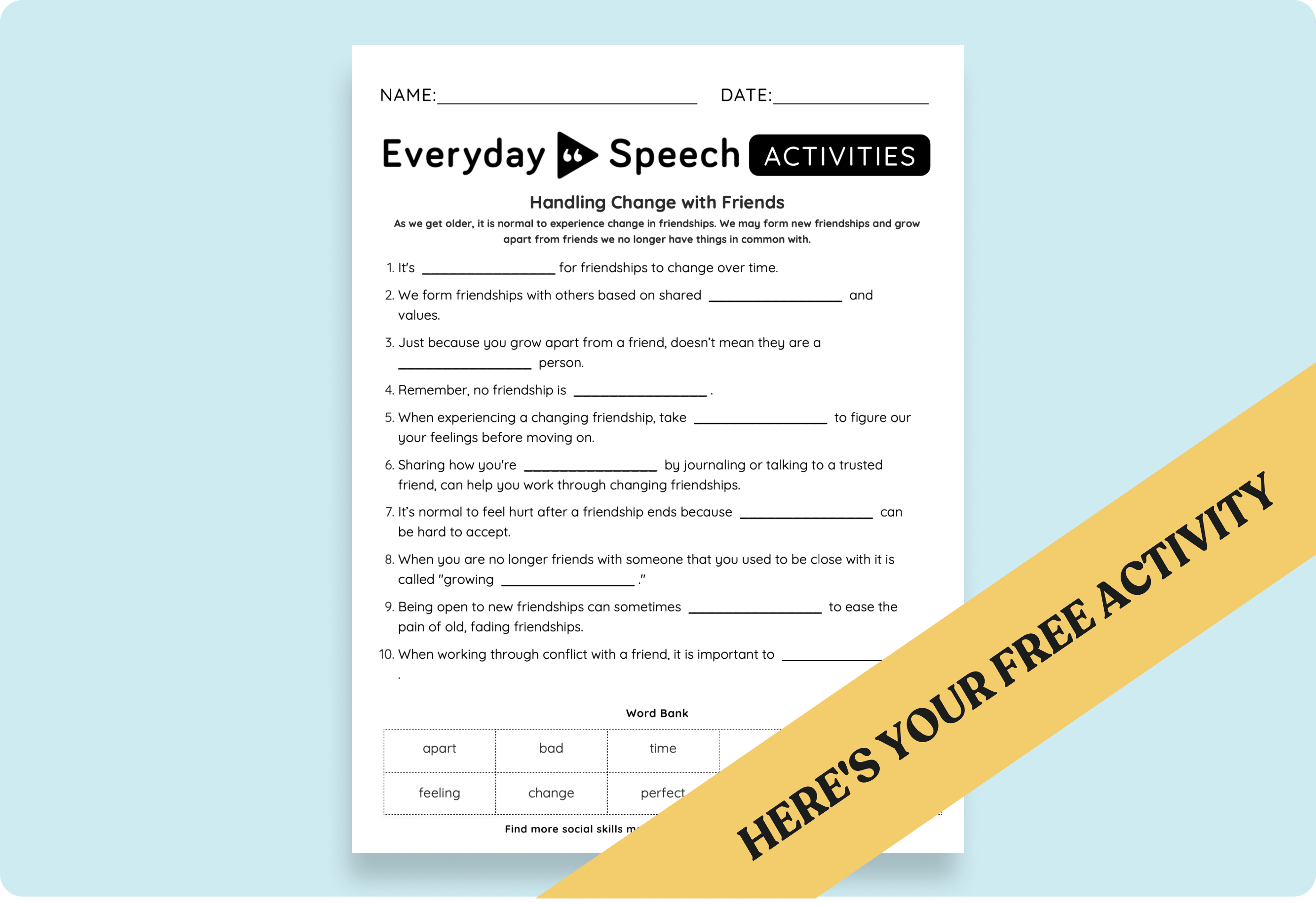
How to use it: Use it in advisory, class lessons on peer relationships, or small-group settings. Begin by normalizing that friendships change over time and invite students to name ways friendships shift. Then distribute the “Handling Change with Friends” worksheet, ask students to work through scenarios and personal reflections, and brainstorm responses together as a group. End by having each student choose one strategy to try when friendships change in their lives.
Relationship Ruler
Middle School Free Poster & Lesson Plan: Relationship Ruler
This free resource helps middle school students use the Relationship Ruler tool for friendship skills to assess how healthy their friendships are, reflect on their dynamics, and identify ways to strengthen them. It includes a printable poster and guided lesson plan.
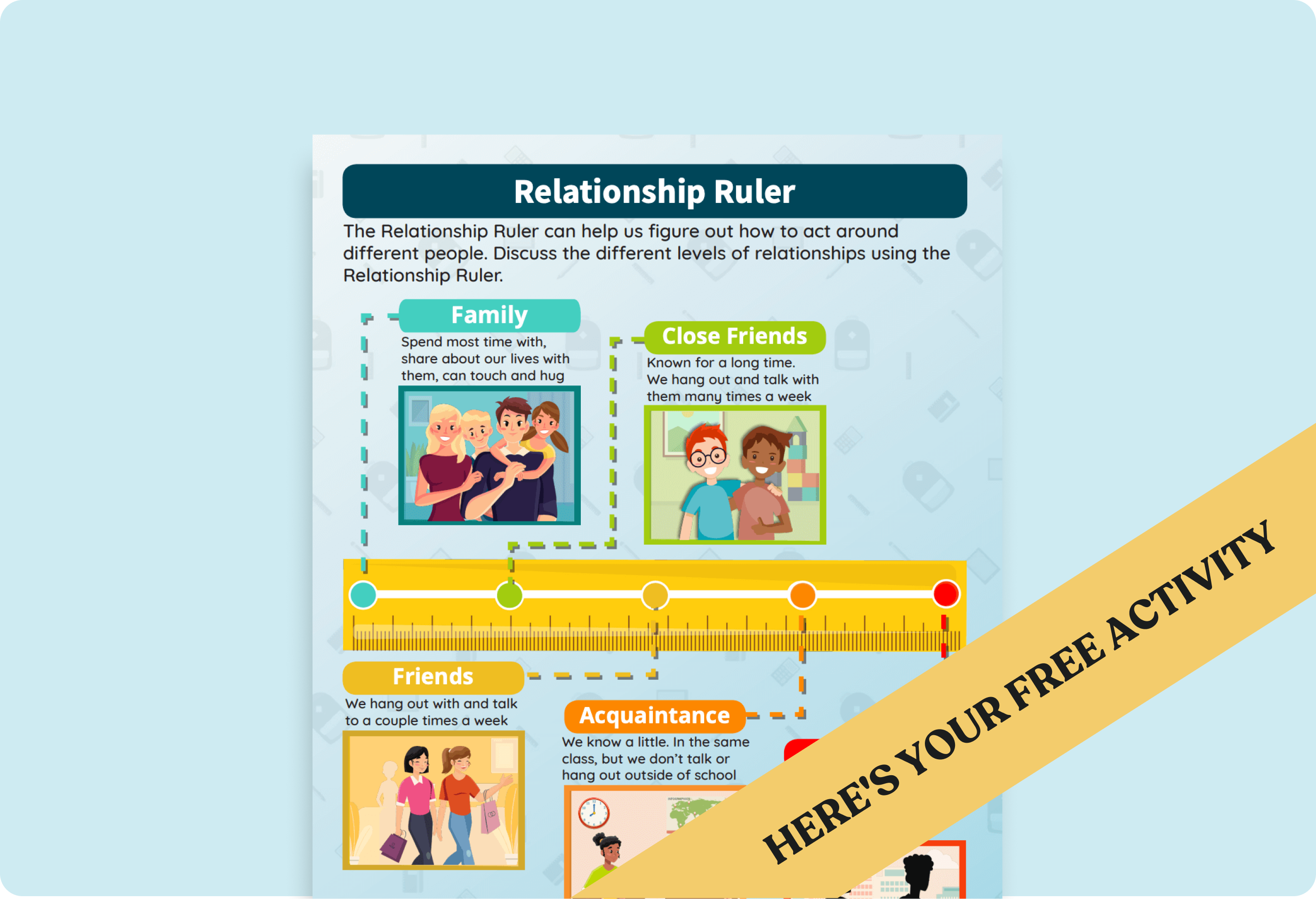
How to use it: Use it in advisory, small-group settings, or classroom lessons about peer relationships. Start by explaining that friendships can feel different over time and that it’s helpful to evaluate them intentionally. Introduce the Relationship Ruler poster, walk through its scales and prompts with students, then have them complete the ruler individually using a current friendship. Follow with a discussion about patterns or surprises, and ask students to set one small goal for improving or balancing a friendship.
Being a Good Sport Discussion
Middle School Free Discussion Guide: Being a Good Sport
This free discussion guide supports middle schoolers in thinking about being a good sport through structured reflection on fairness, handling wins and losses, and respectful behavior in play.
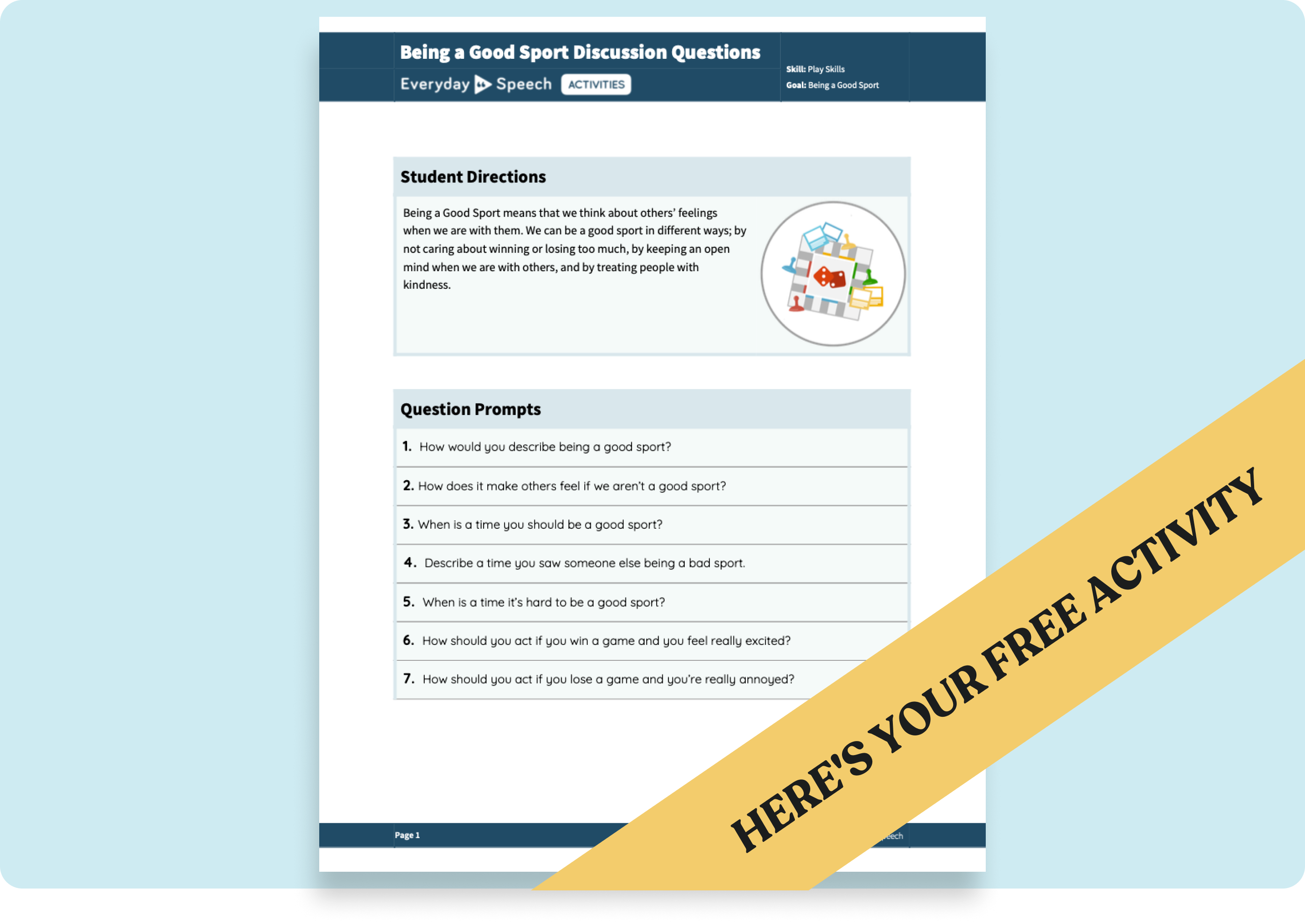
How to use it: Use it in classroom circles, advisory, or small-group sessions. Start by posing an open question (e.g. “What does being a good sport look like to you?”), then distribute or display the discussion questions. Encourage students to respond and elaborate, prompt deeper reflection by asking “Why?” or “How would you do that differently next time?”, and—if time allows—follow up with a quick game or scenario to practice these behaviors in action.
Giving Compliments
High School Free Lesson Plan: Giving Compliments
This free lesson plan helps high school students learn how to give and receive compliments in a sincere, socially appropriate way. It guides learners to focus on others’ strengths, time compliments thoughtfully, and accept praise with gratitude.
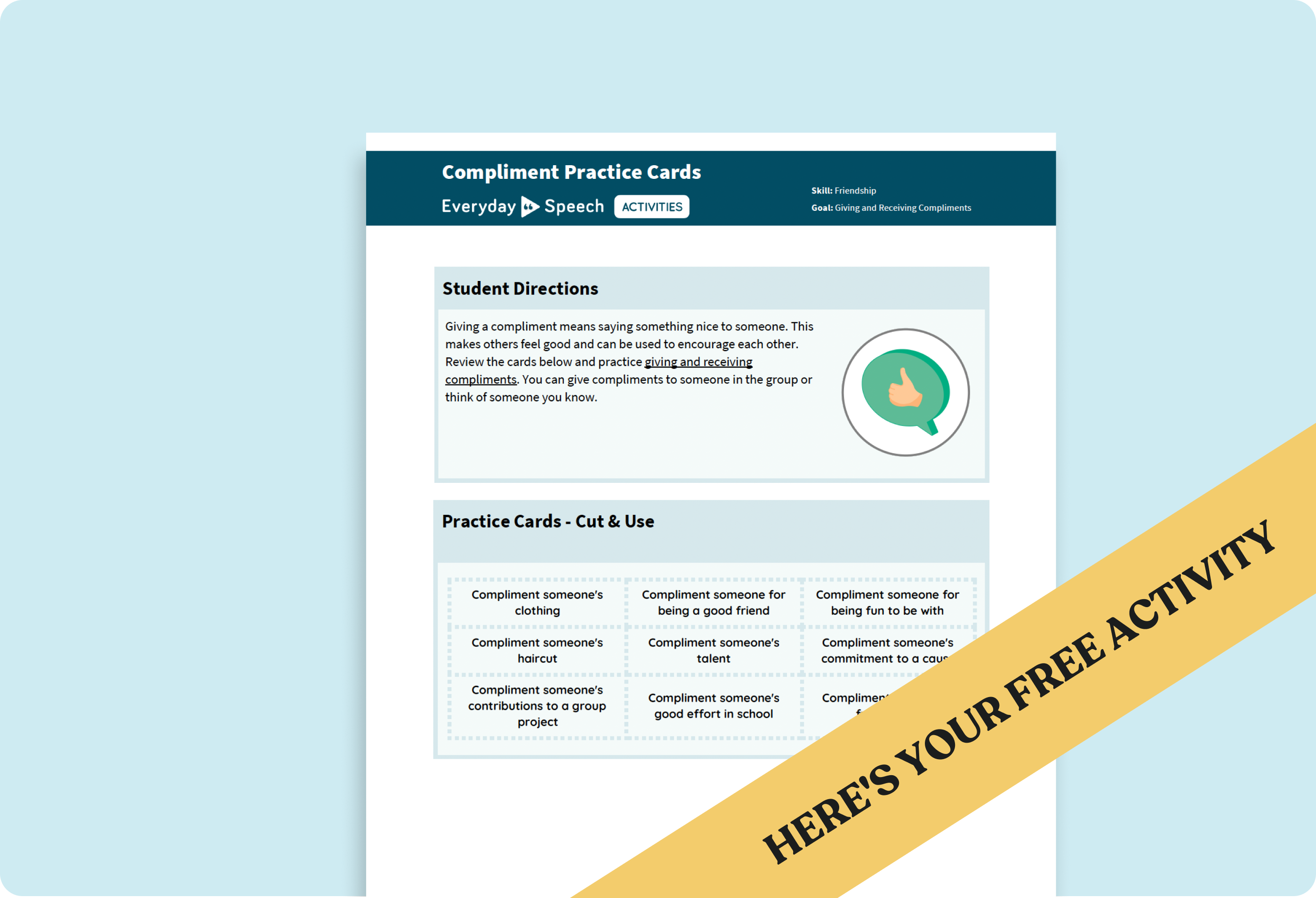
How to use it: Use it in a social skills class or advisory period. Begin with a discussion about why compliments matter, then have students work through the “Compliment Practice Cards” worksheet (with nine scenarios) to role-play giving compliments in a safe setting. You can print or project it digitally.
Asking Friends to Hang Out
High School Free Lesson Plan: Asking Friends to Hang Out
This free lesson plan teaches high school students how to ask friends to hang out in a clear, respectful way. It walks through a three-step framework for making social invitations: picking the right moment, stating the plan, and responding graciously to any answer.
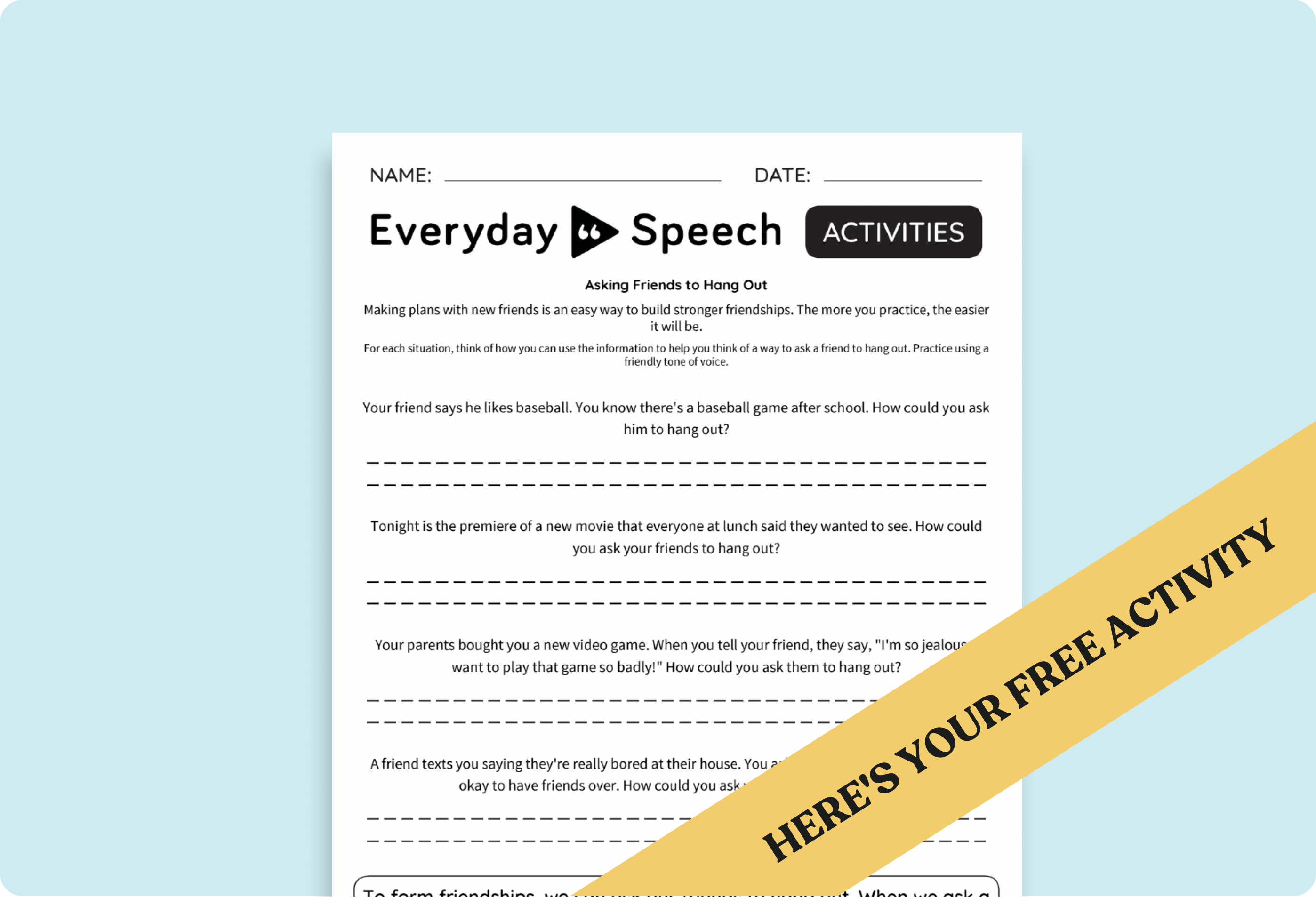
How to use it: Use it in small groups, advisory time, or social skills classes. Start with a discussion about why it’s hard to ask someone to hang out, then model the three-step method and let students role-play asking classmates (or hypothetical peers) different scenarios. Add debriefing to talk through challenges and next-step planning.
Being a Good Sport
High School Free Worksheet & Lesson Plan: Being a Good Sport
This free resource helps high school students practice how to be a good sport by guiding them through realistic scenarios and prompting reflection on graciousness, handling wins/losses, and encouraging others.
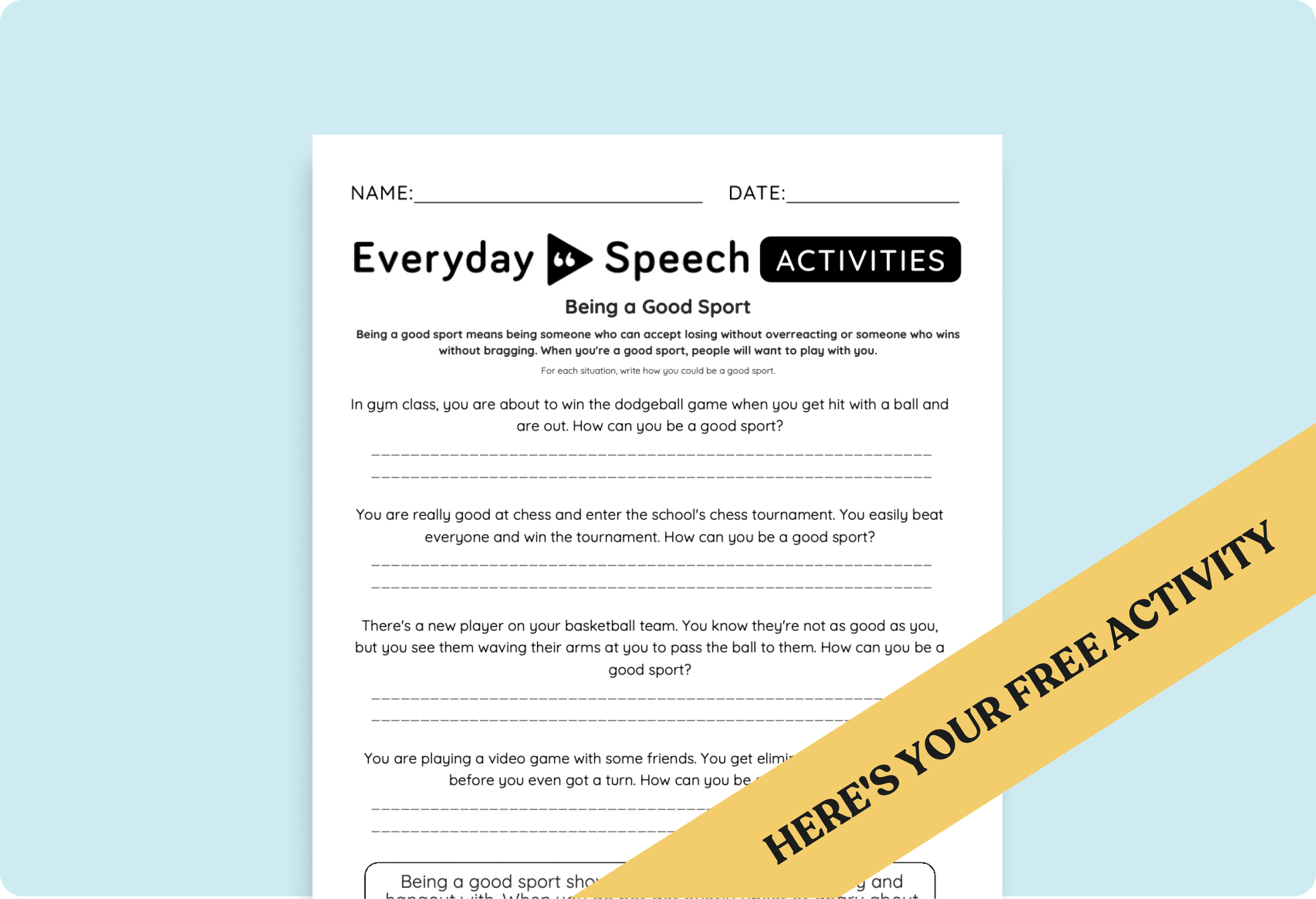
How to use it: Use it in advisory, small-group settings, or classroom activities built around peer interaction. Begin with a discussion: What does “good sportsmanship” look like? Then distribute the “Being a Good Sport” worksheet, have students respond to scenarios, discuss their reasoning in pairs or groups, and compare approaches. Finish by asking students to pick one sportsmanship behavior they’ll practice next time they play or compete.
Tips for Implementing Friendship Skills Activities
Friendship skills are best learned through consistent, structured practice in real contexts. Here are some practical ways to make your activities more effective:
- Keep lessons short and frequent. Friendship skills stick when practiced regularly in small doses.
- Model before expecting. Show students exactly what the skill looks and sounds like before asking them to try it.
- Reinforce throughout the day. Prompt and praise skill use during transitions, playtime, and group work.
- Use visuals. Posters, cue cards, and worksheets make abstract ideas easier to understand.
- Create safe practice spaces. Role-play and guided activities let students try skills without high social pressure.
- Follow up and reflect. Brief debriefs after activities help students connect what they practiced to real-life situations.
Friendship Skills Activities vs Social Skills Activities
Friendship skills are a specific set of social skills that focus on building and maintaining peer relationships. Social skills cover a wider range of interpersonal abilities, including communicating with adults, following group norms, and navigating different social contexts.
Teaching friendship skills helps students connect with their peers and develop meaningful relationships. Teaching broader social skills supports success in all types of social situations. Both are important for students to feel confident and connected at school.
Get Free Activities for Friendship Skills
Printable lessons, games, posters, and interactive activities that teach essential friendship skills with zero prep required
Bringing Friendship Skills to Life in Your Classroom
Friendship skills shape how students connect with one another, solve problems, and build lasting relationships. By teaching these skills intentionally, educators give students the tools they need to participate fully in their school communities and thrive socially and academically.
The free activities on this page make it simple to introduce, model, and practice friendship skills at every grade level. Whether you use a quick printable, a structured lesson, or a game-based activity, each resource offers meaningful ways to support students as they grow their peer relationships.
Start with one or two activities that match your students’ needs and build from there. Consistent practice, clear modeling, and supportive reinforcement will help students bring friendship skills to life both inside and outside the classroom.
Friendship Skills FAQs
What are friendship skills?
Friendship skills are the communication and social abilities students use to build and maintain positive peer relationships. These include skills like starting conversations, sharing, inviting others to join, handling conflicts, and showing good sportsmanship.
How can I teach friendship skills in the classroom?
The best way to teach friendship skills is through explicit instruction, modeling, guided practice, and frequent reinforcement during the school day. Use structured lessons, visual supports, and interactive activities to help students apply what they learn.
Why are friendship skills important?
Friendship skills help students feel included, build confidence, and develop empathy. They support classroom community, reduce conflict, and give students tools to navigate peer interactions successfully.
What are fun friendship activities for students?
Interactive games, role-plays, and printable activities work especially well. Activities that focus on turn-taking, invitations, problem-solving, and perspective-taking give students real opportunities to practice friendship skills in meaningful contexts.
What if students struggle to make or keep friends?
Some students need more structured support and repeated practice. Start with small, explicit steps, model skills frequently, use visual reminders, and give plenty of opportunities for guided practice in low-pressure settings.
